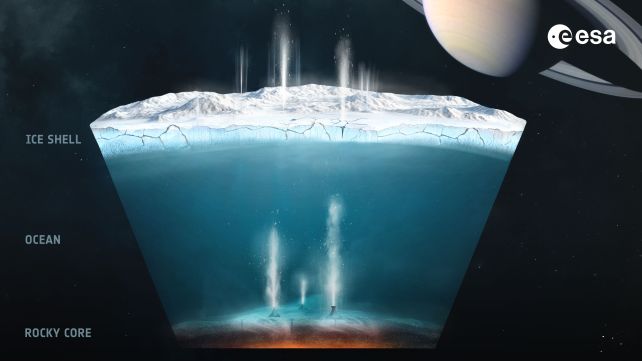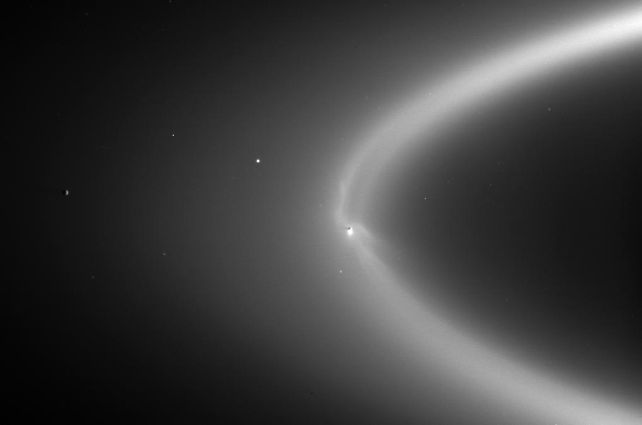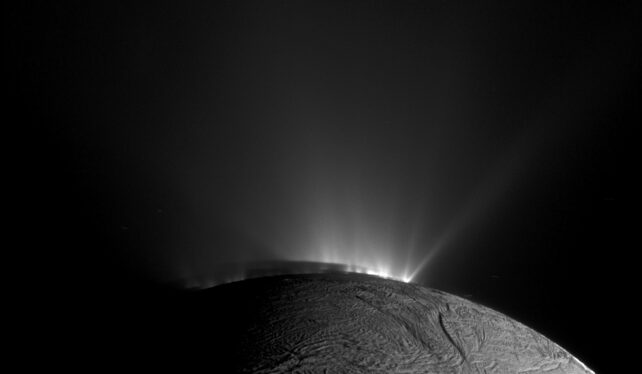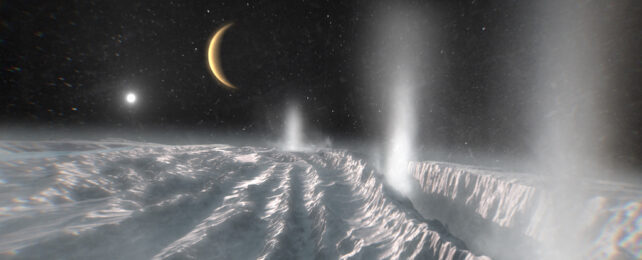A fresh look at data collected by NASA's Cassini probe nearly two decades ago has revealed new, complex organic molecules on Saturn's icy moon Enceladus – pointing to tantalizing chemistry taking place deep beneath its hidden ocean.
In plumes of water ice spewing from cracks in Enceladus's shell, a team led by astrobiologist Nozair Khawaja from the University of Stuttgart in Germany has identified a large number of organic molecules, including several seen for the first time in this context.
This study marks the first detailed chemical analysis of freshly ejected plume grains, rather than the older, space-weathered grains in Saturn's E ring.
Related: Saturn's Ocean Moon Enceladus Has All The Building Blocks For Life, Research Shows
Although the processes that forge these molecules are non-biological, or abiotic, many of them are crucial for biological systems or can serve as precursors to life.
"There are many possible pathways from the organic molecules we found in the Cassini data to potentially biologically relevant compounds, which enhances the likelihood that the moon is habitable," Khawaja says.

What's even more intriguing is that the detected molecules imply an environment similar to some on Earth in which we know life thrives – deep-ocean hydrothermal systems. Hydrothermal vents on Earth produce many of the same classes of organics, and the new results suggest similar seafloor chemistry may be active on Enceladus today.
Enceladus is one of the most promising locations in the Solar System to search for extraterrestrial life. We know that there is a vast liquid ocean deep under its kilometers-thick icy exterior; indeed, the Cassini Saturn probe made multiple dives through giant plumes of water vapor and ice spurting out from below.
In addition, the way Enceladus is tugged about by the gravitational complexities at play in the Saturn system pulls and pushes at the core in a way that would generate significant internal heat.
At cold Saturn distances from the Sun, life as we know it on Earth might struggle to rely on photosynthesis. Yet deep at the bottom of Earth's oceans, where the light from the Sun never reaches, ecosystems thrive around scorchingly hot volcanic vents that belch life-supporting chemistry into the surrounding waters. Scientists believe that similar vents could exist on Enceladus.

Cassini samples of the material spewed out from Enceladus, which forms Saturn's E ring, consisting predominantly of tiny ice particles, have revealed the presence of organic molecules. Analysis of samples collected directly from the plumes between 2005 and 2015 also suggested fascinating chemistry in the moon's oceans.
There were, however, some barriers to a detailed analysis of the data collected using Cassini's Cosmic Dust Analyzer (CDA) instrument. The CDA collected hundreds of thousands of ice grain spectra from Saturn's E ring, providing a wealth of data to comb through. In addition, the plume fly-through data were significantly noisier, making them much more challenging to analyze.
In 2008, Cassini dove through a plume at a tremendous speed of 17.7 kilometers (11 miles) per second, the highest speed of all its Enceladus flybys. This speed produces data that can't be obtained any other way, even if it's extremely noisy.
"The ice grains contain not just frozen water, but also other molecules, including organics," Khawaja explains.
"At lower impact speeds, the ice shatters, and the signal from clusters of water molecules can hide the signal from certain organic molecules. But when the ice grains hit CDA fast, water molecules don't cluster, and we have a chance to see these previously hidden signals."
Using newly developed analysis techniques – including laboratory spectral matching against large open databases – he and his colleagues were able to cut through the noise and find those signals, revealing chemistry freshly ejected from Enceladus's interior, compared to the older material in the E ring.

The results revealed a range of aromatics, aldehydes, esters, ethers, and alkenes, as well as hints of nitrogen-oxygen compounds. The presence of these compounds confirms that similar molecules found in Saturn's E ring originate from within Enceladus, rather than being the product of space weathering.
With earlier Cassini discoveries of salts, hydrogen, and phosphates, this means five of the six CHNOPS elements essential for life have now been detected. Sulfur is the only one left to find.
These compounds are all produced abiotically, the team says, but many of them are precursors to biological chemistry. Moreover, they're consistent with a hydrothermal environment – representing the best evidence to date that these systems exist on Enceladus.
From here, the research possibilities are even more exciting than ever.
"Even not finding life on Enceladus would be a huge discovery, because it raises serious questions about why life is not present in such an environment when the right conditions are there," Khawaja says.
"There is much more in the data that we are currently exploring, so we are looking forward to finding out more in the near future."
The research has been published in Nature Astronomy.
